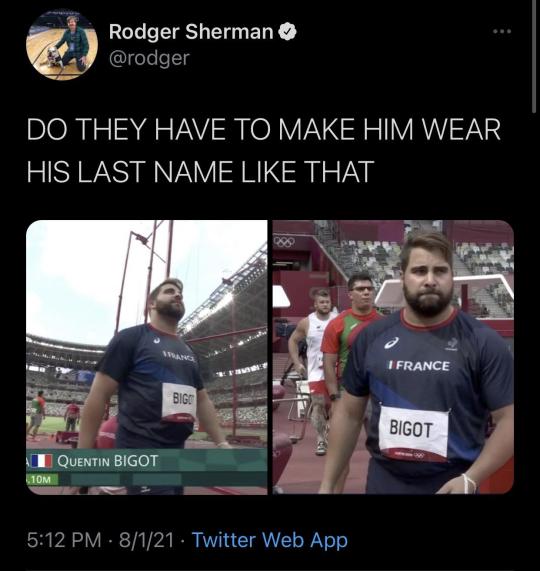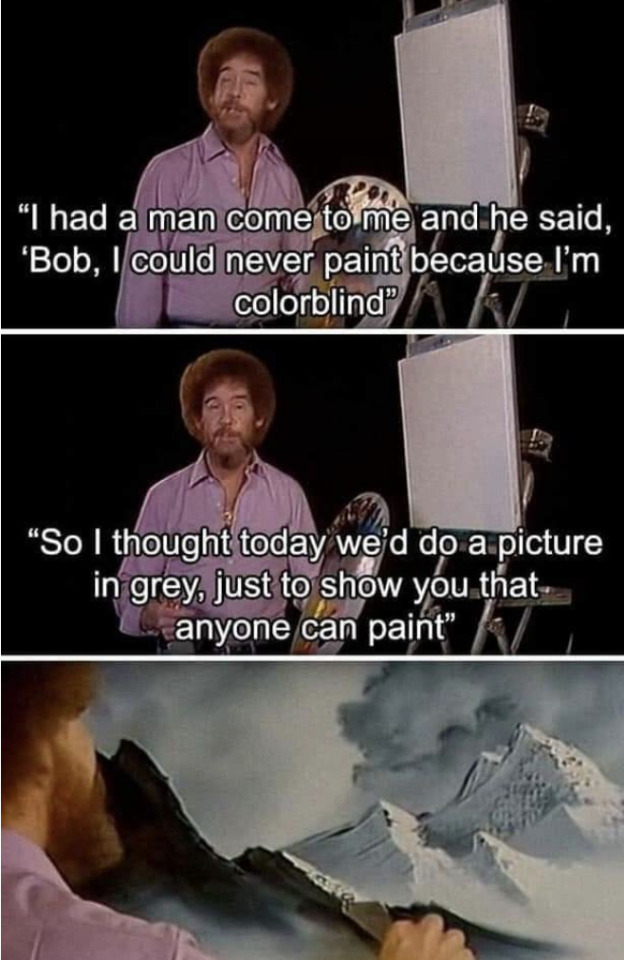Text

This is how I celebrated the Ides of March last year. I don't know how to commit to the bit any more this year, but I'll take suggestions.
37K notes
·
View notes
Text
Happy Public Domain Day 2025 to all who celebrate

If you'd like an essay-formatted version of this post to read or share, here's a link to it on pluralistic.net, my surveillance-free, ad-free, tracker-free blog:
https://pluralistic.net/2024/12/17/dastar-dly-deeds/#roast-in-piss-sonny-bono

In 1976, Congress set fire to the country's libraries; in 1998, they did it again. Today, in 2024, the flames have died down, and out of the ashes a new public domain is growing. Happy Public Domain Day 2025 to all who celebrate!
For most of US history, copyright was something you had to ask for. To copyright a work, you'd send a copy to the Library of Congress and they'd issue you a copyright. Not only did that let you display a copyright mark on your work – so people would know they weren't allowed to copy it without your permission – but if anyone wanted to figure out who to ask in order to get permission to copy or adapt a work, they could just go look up the paperwork at the LoC.
In 1976, Congress amended the Copyright Act to eliminate the "formality" of copyright registration. Now, all creative works of human authorship were copyrighted "at the moment of fixation" – the instant you drew, typed, wrote, filmed, or recorded them. From a toddler's nursery-school finger-painting to a graffiti mural on a subway car, every creative act suddenly became an article of property.
But whose property? That was on you to figure out, before you could copy, publish, perform, or preserve the work, because without registration, permissions had to start with a scavenger hunt for the person who could grant it. Congress simultaneously enacted a massive expansion of property rights, while abolishing the title registry that spelled out who owned what. As though this wasn't enough, Congress reached back in time and plopped an extra 20 years' onto the copyrights of existing works, even ones whose authors were unknown and unlocatable.
For the next 20 years, creative workers, archivists, educators and fans struggled in the face of this regime of unknowable property rights. After decades of well-documented problems, Congress acted again: they made it worse.
In 1998, Congress passed the Sonny Bono Copyright Act, AKA the Mickey Mouse Preservation Act, AKA the Copyright Term Extension Act. The 1998 Act tacked another 20 years onto copyright terms, but not just for works that were still in copyright. At the insistence of Disney, Congress actually yanked works out of the public domain – works that had been anthologized, adapted and re-issued – and put them back into copyright for two more decades. Copyright stretched to the century-plus "life plus 70 years" term. Nothing entered the public domain for the next 20 years.
So many of my comrades in the fight for the public domain were certain that this would happen again in 2018. In 2010, e-book inventor and Project Gutenberg founder Michael S Hart and I got into a friendly email argument because he was positive that in 2018, Congress would set fire to the public domain again. When I insisted that there was no way this could happen given the public bitterness over the 1998 Act, he told me I was being naive, but said he hoped that I was right.
Michael didn't live to see it, but in 2019, the public domain opened again. It was an incredible day:
https://archive.org/details/ClosingKeynoteForGrandReopeningOfThePublicDomainCoryDoctorowAtInternetArchive
No one has done a better job of chronicling the fortunes of our fragile, beautiful, bounteous public domain than Jennifer Jenkins and James Boyle of Duke University's Center for the Study of the Public Domain. Every year from 2010-2019, Boyle and Jenkins chronicled the works that weren't entering the public domain because of the 1998 Act, making sure we knew what had been stolen from our cultural commons. In so many cases, these works disappeared before their copyrights expired, for example, the majority of silent films are lost forever.
Then, in 2019, Jenkins and Boyle got to start cataloging the works that were entering the public domain, most of them from 1923 (copyright is complicated, so not everything that entered the public domain in 2019 was from that year):
https://web.law.duke.edu/cspd/publicdomainday/2019/
Every year since, they've celebrated a new bumper crop. Last year, we got Mickey Mouse!
https://pluralistic.net/2023/12/15/mouse-liberation-front/#free-mickey
In addition to numerous other works – by Woolf, Hemingway, Doyle, Christie, Proust, Hesse, Milne, DuBois, Frost, Chaplin, Escher, and more:
https://pluralistic.net/2023/12/20/em-oh-you-ess-ee/#sexytimes
Now, 2024 was a fantastic year for the public domain, but – as you'll see in the 2025 edition of the Public Domain Day post – 2025 is even better:
https://web.law.duke.edu/cspd/publicdomainday/2025/
So what's entering the public domain this year? Well, for one thing, there's more of the stuff from last year, which makes sense: if Hemingway's first books entered the PD last year, then this year, we'll the books he wrote next (and this will continue every year until we catch up with Hemingway's tragic death).
There are some big hits from our returning champions, like Woolf's To the Lighthouse and A Farewell to Arms from Hemingway. Jenkins and Boyle call particular attention to one book: Faulkner's The Sound and the Fury, its title taken from a public domain work by Shakespeare. As they write, Faulkner spoke eloquently about the nature of posterity and culture:
[Humanity] is immortal, not because he alone among creatures has an inexhaustible voice, but because he has a soul, a spirit capable of compassion and sacrifice and endurance…The poet’s voice need not merely be the record of man, it can be one of the props, the pillars to help him endure and prevail.
The main attraction on last year's Public Domain Day was the entry of Steamboat Willie – the first Mickey Mouse cartoon – into the public domain. This year, we're getting a dozen new Mickey cartoons, including the first Mickey talkie:
https://en.wikipedia.org/wiki/Mickey_Mouse_(film_series)#1929
Those 12 shorts represent a kind of creative explosion for the Disney Studios. Those early Mickey cartoons were, each and every one, a hybrid of new copyrighted works and the public domain. The backbone of each Mickey short was a beloved, public domain song, with Mickey's motion synched to the beat (animators came to call this "mickey mousing"). In 1929, there was a huge crop of public domain music that anyone could use this way:
Blue Danube, Pop Goes the Weasel, Yankee Doodle, Here We Go Round the Mulberry Bush, Ach Du Lieber Augustin, Listen to the Mocking Bird, A-Hunting We Will Go, Dixie, The Girl I Left Behind Me, a tune known as the snake charmer song, Coming Thru the Rye, Mary Had a Little Lamb, Auld Lang Syne, Aloha ‘Oe, Turkey in the Straw, My Bonnie Lies Over the Ocean, Habanera and Toreador Song from Carmen, Lizst’s Hungarian Rhapsody No. 2, and Goodnight, Ladies.
These were recent compositions, songs that were written and popularized in the lifetimes of the parents and grandparents who took their kids to the movies to see Mickey shorts like "The Barn Dance," "The Opry House" and "The Jazz Fool." The ability to plunder this music at will was key to the success of Mickey Mouse and Disney. Think of all the Mickeys and Disneys we've lost by locking up the public domain for the past half-century!
This year, we're getting some outstanding new old music for our public domain. The complexities of copyright terms mean that compositions from 1929 are entering the public domain, but we're only getting recordings from 1924. 1924's outstanding recordings include:
George Gershwin performing Rhapsody in Blue, Jelly Roll Morton playing Shreveport Stomp, and an early recording from contralto and civil rights icon Marian Anderson, who is famous for her 1939 performance to an integrated audience of over 75,000 people at the Lincoln Memorial. Anderson’s 1924 recording is of the spiritual Nobody Knows the Trouble I’ve Seen.
While the compositions include Singin' in the Rain, Ain't Misbehavin', An American in Paris, Bolero, (What Did I Do to Be So) Black and Blue, Tiptoe Through the Tulips, Happy Days Are Here Again, What Is This Thing Called, Love?, Am I Blue? and many, many more.
On the art front, we're getting Salvador Dali's earliest surrealist masterpieces, like Illumined Pleasures, The Accommodations of Desire, and The Great Masturbator. Dali's contemporaries are not so lucky: after a century, the early history of the works of Magritte are so muddy that it's impossible to say whether they are in or out of copyright.
But there's plenty of art with clearer provenance that we can welcome into the public domain this year, most notably, Popeye and Tintin. As the first Popeye and Tintin comics go PD, so too do those characters.
The idea that a fictional character can have a copyright separate from the stories they appear in is relatively new, and it's weird and very stupid. Courts have found that the Batmobile is a copyrightable character (Batman won't enter the public domain until 2035).
Copyright for characters is such a muddy, gross, weird idea. The clearest example of how stupid this gets comes from Sherlock Holmes, whose canon spans many years. The Doyle estate – a rent-seeking copyright troll – claimed that Holmes wouldn't enter the public domain until every Holmes story was in the public domain (that's this year, incidentally!).
This didn't fly, so their next gambit was to claim copyright over those aspects of Holmes's character that were developed later in the stories. For example, they claimed that Holmes didn't show compassion until the later stories, and, on that basis, sued the creators of the Enola Holmes TV show for depicting a gender-swapped Sherlock who wasn't a total dick:
https://www.theguardian.com/books/2020/dec/22/lawsuit-copyright-warmer-sherlock-holmes-dismissed-enola-holmes
As the Enola lawyers pointed out in their briefs, this was tantamount to a copyright over emotions: "Copyright law does not allow the ownership of generic concepts like warmth, kindness, empathy, or respect, even as expressed by a public domain character – which, of course, belongs to the public, not plaintiff."
When Mickey entered the public domain last year, Jenkins did an excellent deep dive into which aspects of Mickey's character and design emerged when:
https://web.law.duke.edu/cspd/mickey/
Jenkins uses this year's entry of Tintin and Popeye into the public domain to further explore the subject of proprietary characters.
Even though copyright extends to characters, it only covers the "copyrightable" parts of those characters. As the Enola lawyers wrote, the generic character traits (their age, emotional vibe, etc) are not protected. Neither is anything "trivial" or "minuscule" – for example, if a cartoonist makes a minor alteration to the way a character's pupils or eyes are drawn, that's a minor detail, not a copyrightable element.
The biggest impediment to using public domain characters isn't copyright, it's trademark. Trademark is very different from copyright: foundationally, trademark is the right to protect your customers from being deceived by your competitors. Coke can use trademark to stop Pepsi from selling its sugary drinks in Coke cans – not because it owns the word "Coke" or the Coke logo, but because it has been deputized to protect Coke drinkers from being tricked into buying not-Coke, thinking that they're getting the true Black Waters of American Imperialism.
Companies claim trademarks over cartoon characters all the time, and license those trademarks on food, clothing, toys, and more (remember Popeye candy cigarettes?).
Indeed, Hearst Holdings claims a trademark over Popeye in many traditional categories, like cartoons, amusement parks, ads and clothes. They're also in the midst of applying for a Popeye NFT trademark (lol).
Does that mean you can't use Popeye in any of those ways? Nope! All you need to do is prominently mention that your use of Popeye is unofficial, not associated with Hearst, and dispel any chance of confusion. A unanimous Supreme Court decision (in Dastar) affirm your right to do so. You can also use Popeye in the title of your unauthorized Popeye comic, thanks to a case called Rogers v Grimaldi.
This all applies to Tintin, too – a big deal, given that Tintin is managed by a notorious copyright bully who delights in cruelly terrorizing fan artists. Tintin is joined in the public domain by Buck Rogers, another old-timey character whose owners are scumbag rent-seekers.
Congress buried the public domain alive in 1976, and dumped a load of gravel over its grave in 1998, but miraculously, we've managed to exhume the PD, and it has been revived and is showing signs of rude health.
2024 saw the blockbuster film adaptation of Wicked, based on the public domain Oz books. It also saw the publication of James, a celebrated retelling of Twain's Huck Finn from the perspective of Huck's enslaved sidekick.
This is completely normal. It's how art was made since time immemorial. The 40 year experiment in life without a public domain is at an end, and not a minute too soon.
You can piece together a complete-as-possible list of 2025's public domain (including the Marx Brothers' Cocoanuts, Disney's Skeleton Dance, and Del Ruth's Gold Diggers of Broadway) here:
https://onlinebooks.library.upenn.edu/cce/
4K notes
·
View notes
Text
In the ruins of Pompeii, there is a room inside a house where two men were painting on the day Mt. Vesuvius erupted in AD 79.
The master painter was at work on the fresco itself, twining vines in green, men and women looking out of the image to one side. His partner, probably an apprentice or lesser, younger painter, was laying down fresh plaster nearby. We know it was fresh because the pumice left significant pockmarks in it as it dried that we can still see today.
There are holes where a shelf stood holding the different colors of paint, in the wall just below the unfinished fresco. We found jars of paint on the floor - red green blue white yellow black. We found his tools, the brushes and the pot of lime that kept the paint wet.
He spilled lime on the painting.
We can tell that, too. It is caked clear as day over the unfinished work.
In a documentary I am watching, an Italian anthropologist discussing the moment of eruption looks to the cameraman and says, with real sincerity, "We found their tools, but we didn't find them. We hope that they ran away, that they survived."
Next door, a baker left his livestock behind when he fled. We found the skeletal remains of the animals who helped to move the millstone, but we did not find the baker.
Not that we are certain of, anyway.
I just wanted to take a moment to think about a modern Italian anthropologist looking at unfinished paintings and bread turned to stone by ash and time, hoping to himself that those people made it out in time.
We are separated by almost two thousand years, but we still have empathy for lives facing terror beyond their understanding. We still hope against hope that two painters ran out of town and made a new life somewhere else, that they escaped before the final pyroclastic flows descended.
We hope the baker moved to another town.
We recognize ourselves in what was left behind, and hope that these people - who could have been us, but for a trick of time and place - had a fighting chance to survive.
I just.
Sometimes, I love people.
I love us.
507 notes
·
View notes
Photo

Time taken: 2.9 hours
Reference: Sasha Calle
💀 Instagram | Youtube | Commissions 💀
4K notes
·
View notes
Text

Inspiring Bedroom by @jellinadetmar
Get Inspired, visit www.myhouseidea.com
655 notes
·
View notes
Video
why does this whole scene look & sound like a YTP
370K notes
·
View notes
Text
Temples are built for gods. Knowing this a farmer builds a small temple to see what kind of god turns up.
406K notes
·
View notes
Text
The Day I Saw Van Gogh's Genius in a New Light
Japanese version
The other day, I was asked to speak at the Hokkaido Color Universal Design Organization. At the HCUDO there is a facility named the “Color Vision Experience Room” and I had a chance to experience it firsthand. The event I spoke at had, as its main objective, public education about diversity of color vision. The event also sought to promote the idea that any time we make choices about colors, for example in design, business, and education, we should take this diversity into account.
The “Color Vision Experience Room” uses illumination that is optically filtered to provide a modified spectrum of light. Under this filtered light, a person who has normal color vision sees color much the same as the person who has protan or deutan color vision. These types of color deficiency make it difficult to differentiate certain color combinations. The effort and thought that went into the construction of this room was impressive.
I was able to view various items in the room, and it turned out that experiencing modified color vision with the naked eye had a stronger impact than experiencing it on a computer display in simulation, something of a surprise to me.
There were prints of Vincent van Gogh’s paintings in the room. Under the filtered light, I found that these paintings looked different from the van Gogh which I had previously seen. I love van Gogh’s paintings and have been fortunate to view a number of the originals in various art museums. Vincent van Gogh has, is well known, a somewhat unusual way to use color. Although his use of color is rich, we see lines of diverse colors existing concurrently. Sometimes a point of entirely different color suddenly is interjected. Some people conjecture that van Gogh had color vision deficiency.
However, in the van Gogh images seen in the color vision experience room, to me the incongruity of color and roughness of line quietly disappeared. And each picture had changed into one of brilliance with very delicate lines and shades. This was wonderful to see and experience.
The next day, I had a dinner with the people of HCUDO, and we talked about this phenomenon. One of my friends who has protanomal color vision, a designer and painter, said this to me:
“It’s wonderful, isn’t it? We color deficient people, actually better than color normal people, understand van Gogh’s true nature and appreciate he is the genius of geniuses. In our opinion, van Gogh surely had color vision deficiency. Therefore, color deficient people can better understand his pictures.”
I considered this. After returning home, I viewed van Gogh’s works using the “Chromatic Vision Simulator” software which I had developed. However, the images simply lost their color and the sublime impression I got in the “Color Vision Experience Room” was missing.
Then it occurred to me to ask - Is my friend partially color vision deficient (anomalous trichromat)? Perhaps using a strong color vision deficiency (dichromat) simulation was the wrong approach. How about carrying out the simulation by removing only a specific portion of normal color vision, maybe then I could see van Gogh’s works in that light?
I have developed an app for experiencing differing types of color vision called the “Chromatic Vision Simulator,” with versions for iPhone, iPad, iPod, and Android. It is limited to simulating only dichromats (protanope, deuteranope and tritanope). In the original version it had a slider, wherein one could modify the middle range of color of dichromatic vision versus normal color vision. However, I removed the slider from the newest version due to a request from a color vision specialist: “The slider should be deleted because color vision of an anomalous trichromat is not simulated by simple linear transformation–it may create misunderstanding to those using the software.” (*2013/06/11 “Chromatic Glass” Ver.2.0 is supporting the simulation ratio slider on the simulation mode.)
Following my experience in the “Color Vision Experience Room,” I decided I should use this software as the basis for a new application that would allow for side-by-side color vision simulation. Since this software is a web application, I may exhibit it in the future. (*2013/06/27 The “Chromatic Vision Simulator - Web Edition” Ver.1.1 was released.) It is able to map a middle color - one between the color a protanope sees and the color a color normal individual sees. I applied to it to van Gogh’s works. The results are shown below (with my personal comments - note that I do not claim deep knowledge of art!)
To illustrate the simulation performed here, consider the meaning of “Protanomal simulation (60%).” This is, when an original color is Qc and the simulation color of protanope is Qp where linear transformation is possible between XYZ color space, the new color is Qc(1 - 0.6) + 0.6Qp.
Such a transformation will provide a color closer to the color which protanope sees. This color may not necessarily be the same as the color a protanomal (and other anomalous trichromat) sees but it is a useful starting approximation. As time allows, one test improvement I am considering is to run the simulation for deuteranomal color vision. However, for the time being, I have run it with protanomal simulation. Below I provide some sample pictures which in my opinion best illustrate the sort of color shift referred to in this article.
“Wheat Field Behind Saint-Paul Hospital” (F619)
In the original, what should be wheat is an orange field; above we have green lines mixed with solar light. In the protanomal simulation, the wheat shade backs up the overall presence splendidly and has given depth to the scene. With the reduced sun, I feel that the twilight of autumn is reproduced.
Left: Original / Right: Protanomal simulation (60%)
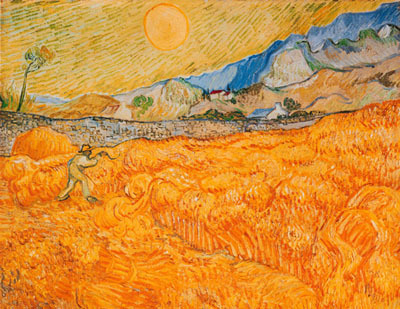
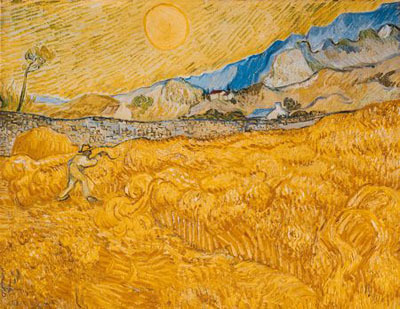
“The Langlois Bridge at Arles” (F570)
A Lady with a Parasol Crossing the Bridge. In the original, the bridge is reflected in the river but it is somewhat surreal. However it projects more naturally in the protanomal simulation. The water surface shimmers with small waves.
Left: Original / Right: Protanomal simulation (60%)

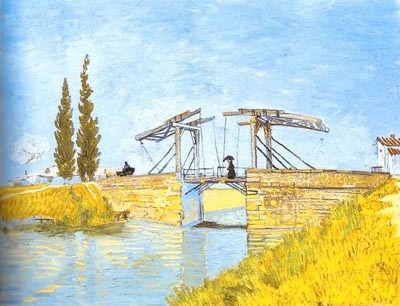
“Starry Night” (F612)
Overall force increased in “The Starry Night.” Contrast the deep darkness and starlight. Clouds are illuminated in the moon.
Left: Original / Right: Protanomal simulation (60%)
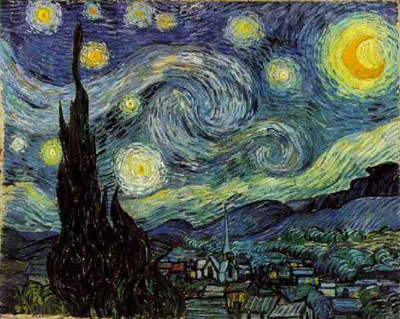
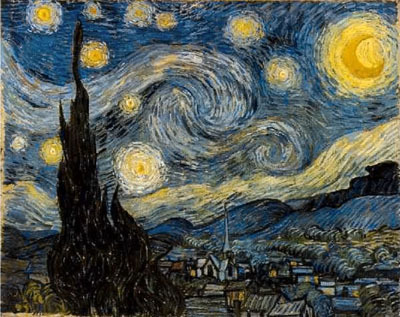
“Flowering Garden with Path” (F429)
The scene with Flowering Garden begins to take on a photographic reality. The scene has gained depth, so that it gives the impression of an overlook.
Left: Original / Right: Protanomal simulation (60%)

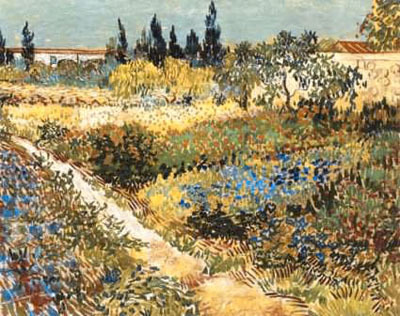
“The Road Menders” (F657)
In the original, the color of the trees and ground is bit strange, and coarse lines are conspicuous in the stones. But after conversion, the trees and the ground begin to look solid, with greater depth felt for the road.
Left: Original / Right: Protanomal simulation (60%)
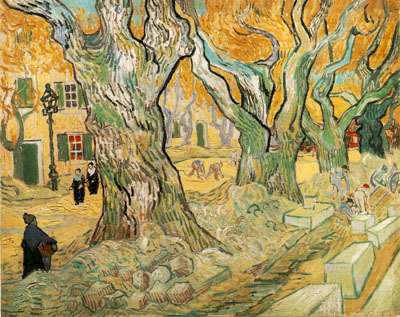
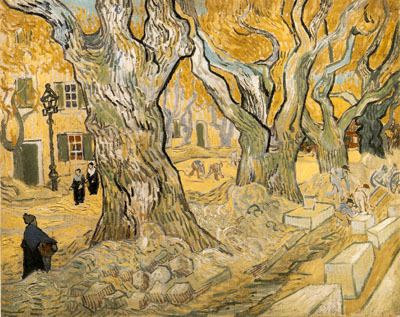
“Sower with Setting Sun after Mille” (F422)
It was truly impressed by “The Sower.” A field in the early-evening. Unevenness of the ground is compared with the light of the sun on the horizon. A farmer casts a shadow. The clods become solid. It seems that footsteps could almost be audible.
Left: Original / Right: Protanomal simulation (60%)
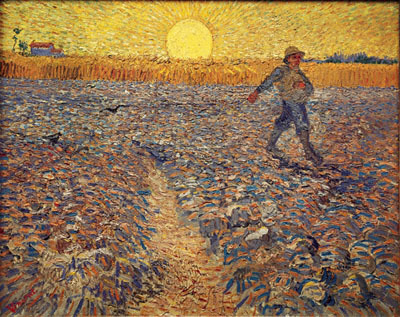
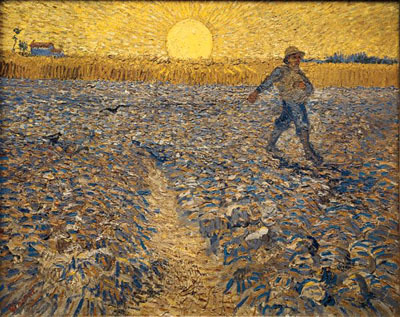
Another highlight is “The Sunflower.” Flowers are more tangible. The Sunflower is such a wonderful picture.
“Sunflowers” (F456)
Left: Original / Right: Protanomal simulation (60%)
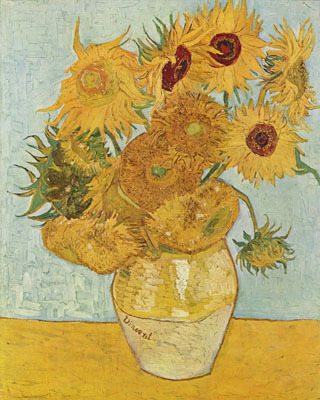
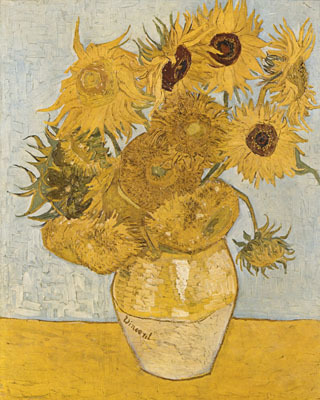
“Sunflowers” (F458)
Left: Original / Right: Protanomal simulation (60%)
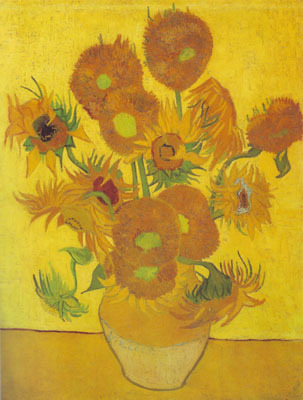
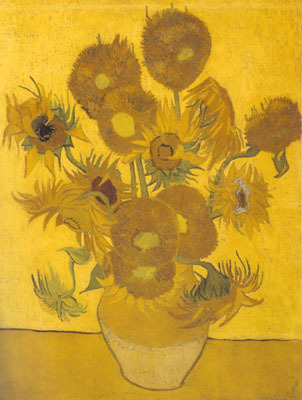
“The Cafe Terrace on the Place du Forum Arles at Night” (F467)
In “The Cafe Terrace at Night,” each of the stones in the pavement become more solid. The building of the slender cafe’s terrace emerges with depth in the moonless night. Under the stars in the infinite sky, people relax and are enjoying a meal and drinks. And the warm light illuminates them.
Left: Original / Right: Protanomal simulation (60%)
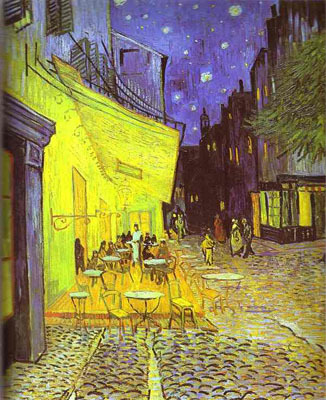
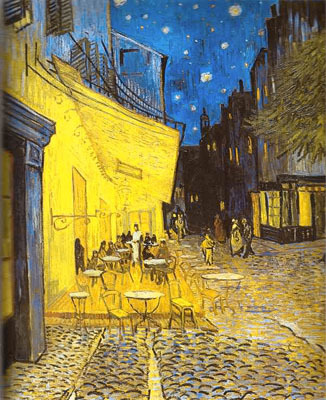
A self-portrait. Stern expression—the man whom one cannot approach easily. Though suffering is held, his aloof and proud figure which dies without compromise emerges further. It speaks to me.
“Self-Portrait” (F627)
Left: Original / Right: Protanomal simulation (60%)
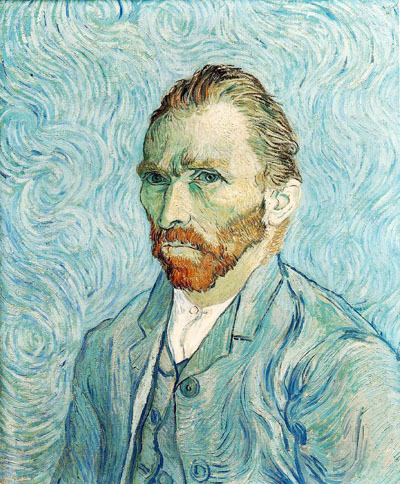
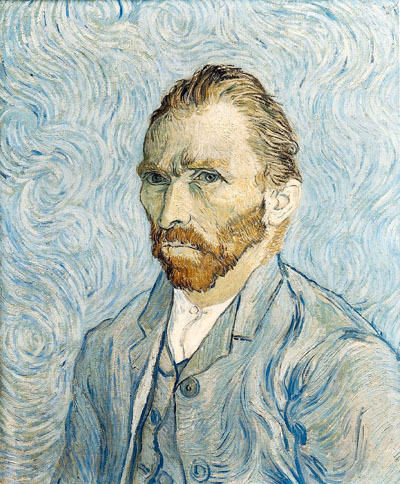
In summary, through the use of this software, I feel that van Gogh’s astounding use of color has become more available to me.
This is something not noticed by the color normal individual, and a dichromate may not notice either. Only an anomalous trichromat, somewhere between dichmomat and normal color vision, may notice it.
Viewing works of van Gogh under this sort of simulation is an exemplar of “the color deficient individual is sometimes superior to the color normal color individual.” This shows those of us who may think, “the color normal individual is superior to the color deficient individual (from the point of seeing and understanding color).” It reminds us that it is normal for one human being to excel in certain ways, while another excels in other ways.
It is reasonable to think that color vision varies by individual nature. I think it is also reasonable to imagine that, possibly, van Gogh’s color vision also differed from normal or “ordinary,” and that he formulated rules how to choose and use paints which were optimal to his eyes.
Of course, the premise of this guess may be wrong. Regardless of whether this hypothesis is correct or incorrect, the fact that his work is wonderful and appeals to many people does not change a bit. I have enjoyed imagining that we can see his work with his own eyes.
Disclaimers: Terms, such as dichromat, anomalous trichromat, normal color vision, protan, protanope, protanomal, deutan, deuteranope, deuteranomal and tritanope are technical terms. The simulation procedure used here does not necessarily reproduce the correct spectrum of the color seen by the color vision deficient.
Please see page 31 of my thesis ”Color vision tools to improve quality of life of people with color vision deficiency” about the details of the simulation procedure used. (Japanese language only.)
(2011/10/16 17:00 the first edition, 2013/08/02 the latest edition, the original Japanese edition was written on 2011/10/12 03:35)
Please contact Mr. Koichi Iga (executive board member of Color Universal Design Organization) if you would like to know more about the “Color Vision Experience Room.” Use the form in his blog.
Kazunori AsadaWeb Site:http://asada.tukusi.ne.jp/
twitter: asada0, facebook: asada0
2K notes
·
View notes
Text

My stepdad is so fucking funny sometimes
93K notes
·
View notes
Text
If the last digit of the notes when you see this is 0, vote option A. If it’s 1 or 2, vote option B. If it’s 3, 4, or 5, vote option C. If it’s 6, 7, 8, or 9, vote option D.
69K notes
·
View notes





